A New Species of the Genus Sinomicrurus Slowinski, Boundy and Lawson, 2001 (Squamata: Elapidae) from Hainan Province, China
2018-06-28LifangPENGLijunWANGLiDINGYiwuZHUJianLUODianchengYANGRuyiHUANGShunqingLUandSongHUANG
Lifang PENG, Lijun WANG, Li DING, Yiwu ZHU, Jian LUO, Diancheng YANG,Ruyi HUANG, Shunqing LU,* and Song HUANG,#,*
1 College of Life and Environment Sciences, Huangshan University, Huangshan 245021, China
2 School of Sciences,Tibet University, Lahsa 850000, China
3 College of Life Sciences, Hainan Normal University, Haikou 571158, China
4 Chengdu Institute of Biology, Chinese Academy of Sciences, Chengdu 610041, China
5 High School Affiliated to Southwest University, Chongqing 400700, China
6 Tunxi No. 1 Middle School, Huangshan 245021, China
1. Introduction
Coral snake is the common name for the often colorful venomous snakes belonging to several genera of the family Elapidae. Traditionally, coral snakes are divided into two clades: the New World coral snakes (the American coral snakes, dorsal scale rows 15 or 17) and the Old World coral snakes (the Asian coral snakes, dorsal scale rows 13 or 15) (McDowell, 1967, 1969; Keogh,1998; Slowinski and Keogh, 2000).
Asian coral snakes are small to medium-sized elapids ranging from tropical to subtropical areas of eastern Asia.Formerly, they belonged to two genera: Calliophis and Maticora. However, Slowinski et al. (2001) designated a new (monotypic) genus Sinomicrurus for a portion of the genus Calliophis based on morphological and cytochrome b sequence characters. Nowadays, the genus Sinomicrurus contains 5 species: S. macclellandi (Reinhardt, 1844),S. japonicus (Günther, 1868), S. sauteri (Steindachner,1913), S. kelloggi (Pope, 1928), S. hatori (Takahashi,1930). S. kelloggi is the only species of the genus Sinomicrurus which has 15 dorsal scale rows, the other four species have 13 dorsal scale rows.
In China, S. kelloggi was recorded from the Municipality and Provinces of Yunnan, Chongqing,Fujian, Guangdong, Guangxi, Guizhou, Hainan, Hunan,Jiangxi, Zhejiang and Anhui (Chen et al., 2013; Ji and Wen, 2002; Sun et al., 2015; Wang et al., 2015; Zhao and Adler, 1993; Zhao, 1998, 2006). But only few records were known in Hainan Province (Chu and Huang, 1990;Shi et al., 2011; Wang, 2014; Zhao, 1990, 2004). The first record of this species on Hainan was on 10 May 1964 from Wuzhishan National Nature Reserve (NNR)(Zhao, 2004) where a single specimen was collected.Later, Chu and Huang (1990) recorded this species from Jianfengling NNR. Based on our study, all specimens that were recorded as S. kelloggi in Hainan Province belong to a new taxon, that we describe as a new species below.
From 2010 to 2016, four coral snakes were sampled from Hainan Province. They have 15 dorsal scale rows,and are morphologically similar toS.kelloggi. However,they are distinct fromS.kelloggiin some external morphological characters, for instance the striped pattern on the head. Based on morphological analyses, these four specimens, while clearly belonging to the genusSinomicrurus, differ from the other five known species and should be considered as a new species of this genus.
2. Materials and Methods
We examined 26 characters in these 4 new coral snakes and 12S.kelloggi. Specimens are preserved in formalin and deposited in the Museum of Huangshan University(see Table 1). Fourteen count characters were taken, for the numbers of preoculars (PreOc), postoculars (PostOc),temporals (Tem), supralabials (SL), infralabials (IL),loreal (Lor) at left and right; the numbers of dorsal scale rows (DSR) (DSR counting at one head length behind the head, at midbody, and at one head length before the vent), ventral plates (VEN), subcaudal plates (SC, the terminal scute excluded from the number of subcaudals),nasals, bands on body (Bands) and tail (Tail Bands),and the number of blotches and spots on the ventral and subcaudal part. Twelve mensural characters were taken as: snout-vent length (SVL), total length (TL), tail length(TaL), head width at broadest point (HW), head length from anterior edge of rostral to posterior end of mandible(HL), head height (HH), rostral width (RW), eye length,eye width, perimeter at neck (PN), perimeter at midbody(PM) and perimeter before vent (PV).Body and tail lengths were measured using a ruler to the closest 1 mm; other measurements were measured with an electronic caliper to 0.1 mm. Terminology for scale counts follows standard colubrid terminology (e.g.,Smith and Campbell, 1994; Smithet al., 2008; Vogel and David, 2010; Vogel and Luo, 2011). Symmetric mensural head characters were measured only on the right side,while asymmetric characters were recorded on both sides.
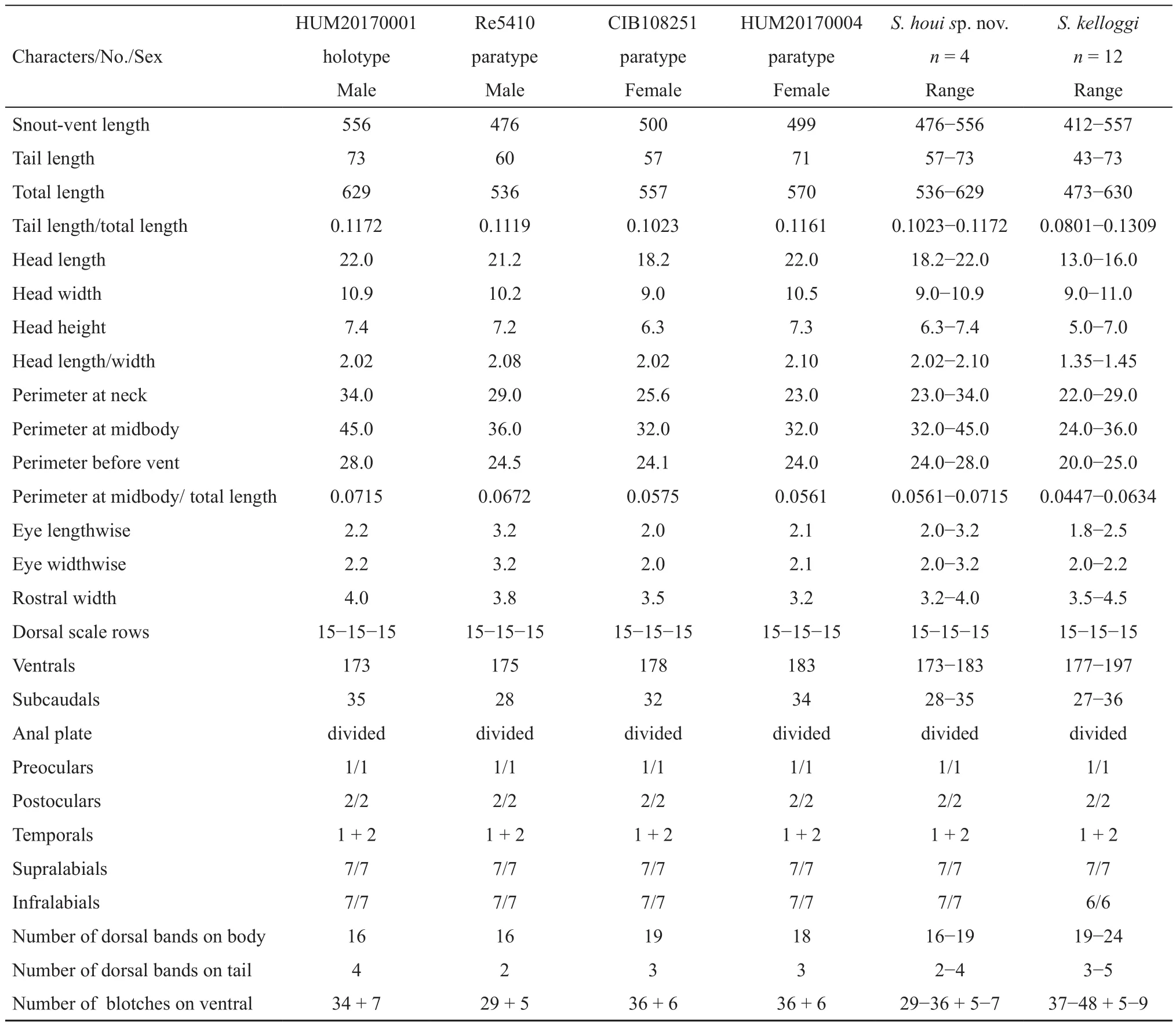
Table 1 Morphometric (mm) and meristic characters for the holotype and paratypes of Sinomicrurus houi sp. nov. and S. kelloggi.
3. Results
Sinomicrurus houi sp. nov. Wang, Peng and Huang(Figures 1, 2, 3)
Calliophis kelloggi— Zhao, 1990,From water onto land:359.
Calliophis kelloggi— Chu and Huang, 1990, Col. Pap.Herp.: 152.
Calliophis kelloggi— Zhao and Adler, 1993, Herpetology of China: 265.
Calliophis kelloggi— Zhao, 1998, Fau. Sin.Rep. Vol. 3,Squa. Serp.: 342–344.
Calliophis kelloggi— Shi and Meng, 2001, A guide to Hainan terrestrial vertebrate: 83.
Calliophis kelloggi— Ji and Wen, 2002, Atlas of reptles of China: 236.
Calliophis kelloggi— Zhao, 2004, Sich. Jour. Zool.: 329.
Sinomicrurus kelloggi— Zhao, 2006, The snakes of China: 297.
Sinomicrurus kelloggi— Shi, Zhao and Wang, 2011,Herpetofauna of Hainan: 259, Plates XXIV-128.
Sinomicrurus kelloggi— Wang, 2014, Wild vertebrate in Diaoluoshan, Hainan, China: 119.
Suggest English name:Hou’s coral snake.
Suggest Chinese name:海南华珊瑚蛇 (Hǎi Nán Huá Shān Hú Shé).
HolotypeHUM20170001 (Figures 1, 2), adult male,was found at the forest edge on a path near a gutterway at the side of Tianchi Lake, Jianfengling NNR, Hainan island, Hainan, China (108°46′ E, 18°39′ N; 805 m a.s.l.;Figure 4), collected by Lijun WANG and Mian HOU on 17 Jun 2010, and deposited in the Museum of Huangshan University.
ParatypesRe5410, adult male, and CIB108251, adult female, from the same locality as the holotype, collected on 25 Mar 2011 by Lijun WANG and Mian HOU.The former deposited in the Shanghai Natural History Museum, the latter deposited in the Herpetological Museum of Chengdu Institute of Biology, Chinese Academy of Sciences. HUM20170004, adult female,collected in the Diaoluoshan NNR, Hainan Island,Hainan, China (109°54′ E, 18°41′ N; 726 m a.s.l.) on 9 Jul 2012 by Yiwu ZHU. The specimen is deposited in the Museum of Huangshan University.
EtymologyThe species name is a patronym honoring Mian HOU (Sichuan Normal University, China), a modern herpetological enthusiast and naturalist. He has been contributing substantially to the taxonomy and life history of amphibians and reptiles for 20 years. He collected 3 of the 4 type specimens.
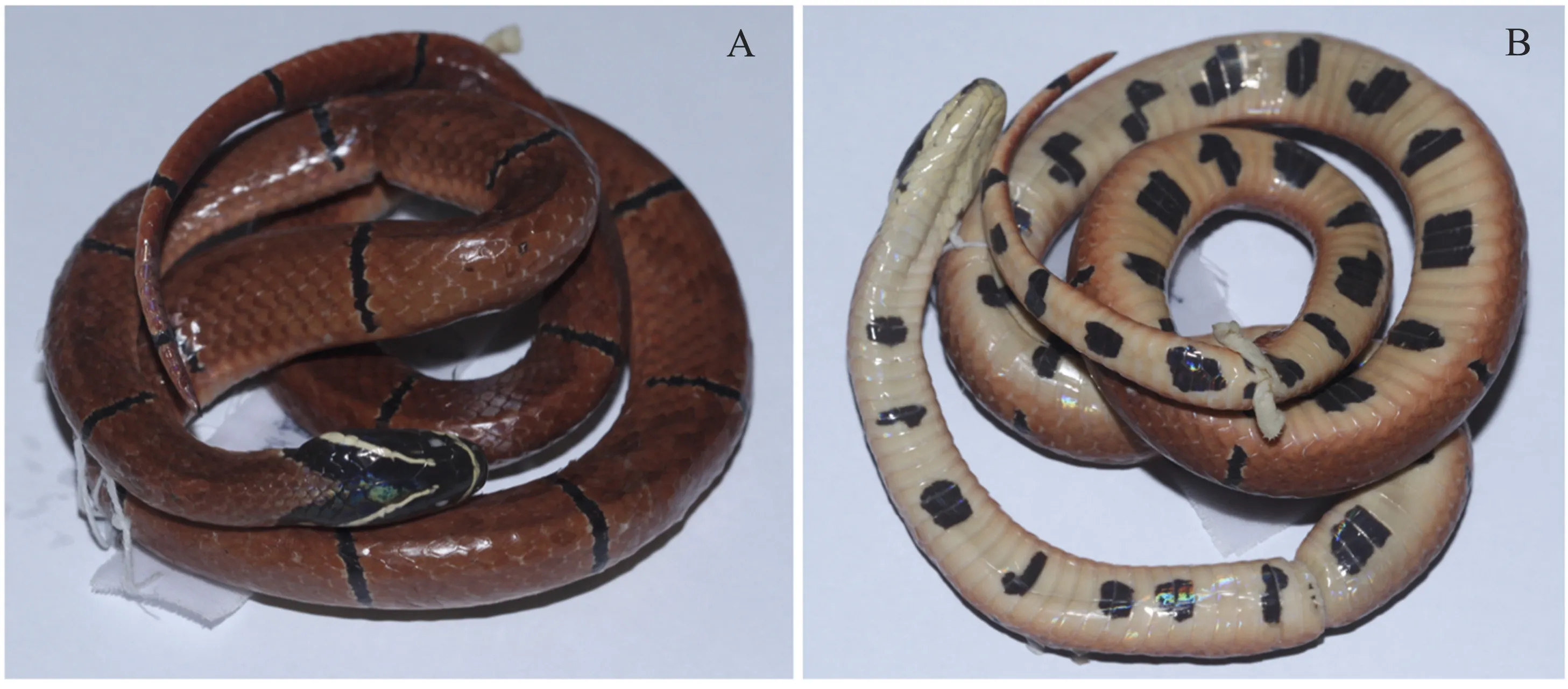
Figure 1 Body of Holotype (HUM20170001, adult male). A: Dorsal; B: Ventral. Photos by Lifang PENG.
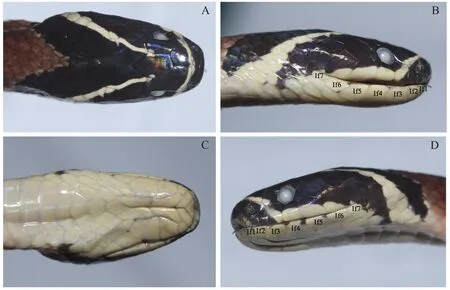
Figure 2 Head of holotype (HUM20170001, adult male). A: Dorsal; B: Right; C: Ventral; D: Left. If: Infralabial. Photos by Lifang PENG and Song HUANG.
DiagnosisSinomicrurus houisp. nov. differs from the known fi ve congeners by a combination of the following characters: 1) dorsal scale rows (DSC) 15: 15: 15, smooth throughout; 2) ventrals (VL) 173–183; 3) subcaudals(SC) 27–38; 4) head relatively elongated, head length(HL) 2.0–2.1 times as long as head width (HW); 5) no loreal; 6) supralabials (SL) 7/7, infralabials (IL) 7/7;7) dorsal surface scarlet, with 16–19 edged yellowish black bands on trunk of body, 2–4 on tail; 8) numbers of ventral spots 34–42; 9) dorsum of head having a narrow white broadwise band in the forefront of head (covering almost all the 3rd, 4th, 5th, 6thsupralabials, preoculars,and continuing through forefront prefrontals) and two symmetric white stripes appearing a Chinese symbol for the figure eight (“八 ”, from both sides of frontal to neck sides and gradually widening); 10) maxillary teeth behind the fangs present.
Description of holotypeAn adult male with SVL 556 mm, Tal 73 mm, TL 629 mm, TaL/TL 0.117; HL 22.0 mm; HW 10.9 mm; HL/HW 2.02; HH 7.4 mm, head distinct from neck; eye length 2.2 mm; eye width 2.2 mm,eye length/width 1.0, pupil round; rostral width 4.0 mm;internasals 2.0 times wider than long, contacting only the nasals laterally; length of internasal suture slightly less than half diameter of eye; prefrontals as wide as long, in contact laterally with nasal, preocular, and supraocular;prefrontal suture 1.8 times diameter of eye; frontal 1.7 times longer than wide; supraoculars 2.2 times longer than wide; parietals 2.3 times longer than wide; parietal suture 0.5 times length of parietals; single preocular, as long as wide, pentagon; 2 postoculars, upper slightly wider than lower, reaching beyond upper and lower borders of eye, respectively; 1 + 2 temporals; 7/7 supralabials, the 3rdand 4thbordering the eye, sixth largest and longest;7/7 infralabials, first pair in contact behind mental,second small, from first to fourth touching anterior chinshields, 4thlargest and contacting anterior and posterior chin-shields; no loreal; preocular and nasal in contact;15–15–15 forebody-midbody-hindbody transverse dorsal scale rows, dorsal scales well smooth; apical pits absent;PN 34.0 mm, PM 45.0 mm, PV 28.0 mm; PM/TL 0.072;ventrals 173; anal plate divided; 35 subcaudals, paired;tail complete, tip round.
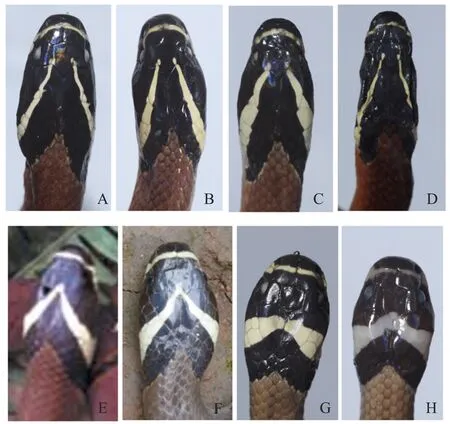
Figure 3 Dorsal head views of Sinomicrurus houi sp. nov.: holotype HUM20170001 (A), paratypes Re5410, CIB108251, HUM20170004(B, C, D), morphological transition type from Vietnam (Orlov et al., 2003) and Yunnan (Sun et al., 2016) (E, F) and typical S. kelloggi from Yunnan Province (Wang et al., 2015) and Anhui (Chen et al., 2013). (G, H). Photos by Lifang PENG and Diancheng YANG (A, B, C, D).
Coloration of the holotype in lifeDorsum of head black,with a narrow white broadwise band in the forefront of head (covering almost all the 3rd, 4th, 5th, 6thsupralabials,preoculars, and continuing through forefront prefrontals)and two symmetric white stripes appearing a Chinese symbol for the figure eight (“八 ”, from both sides of frontal to neck sides and gradually widening); ventral of head creamy yellow; dorsum of body scarlet, turning tangerine towards venter; black dorsal bands finely edged with pale pinkish buff; eye surrounded by dark pigment;16 inerratic dorsal bands on body (all crossing midline),about 1 scales wide; the first dorsal band meets the 14thventral; 4 dorsal bands on tail; 34 black blotches on ventral scales; 7 spots on subcaudal with black.
VariationThe variation in measurement is given in Table 1. The holotype and the paratypes are similar in general aspects.
ComparisonsBased from morphology analysis, the genusSinomicrurushave three species groups, theS.macclellandi,S. kelloggiandS. japonicusgroups.
TheS. macclellandigroup species differs from theS. kelloggigroup species by having 13 scale rows on the body, ventrals 195–241, subcaudals 25–46, 1 + 1 temporals, 6/6 infralabials, with (S. m. macclellandi,S. m. iwasakii,S. m. swinhoei) or without (S. m. gorei,S. m. univirgatus) black rings, the broader band on the head shaped in curve (S. m. macclellandi,S. m. iwasakii,S. m. univirgatus) or straight with irregular border (S.m. gorei,S. m. swinhoei), with a black vertebral stripe and the transverse bars restricted to the sides of the body or totally absent (S. m. univirgatus), having a pair black spots or one irregular spot between the black rings(Günther, 1858, 1964, 1968; Mell, 1929; Nakamura and Ueno, 1963; Orlovet al., 2003; Reinhardt, 1844; Shanget al., 2009; Shiet al., 2011; Smith, 1943; Stejneger,1907; Wall, 1910, 1913, 1923; Zhao, 1998, 2004, 2006).
The above characters refer toS. kelloggiwhich has 15 scale rows on the body, ventrals 154–202, subcaudals 27–38, 1 + 2 temporals, 6/6 (S. kelloggi) or 7/7 (S. houisp. nov.) infralabials, with black rings, the broader band on head shaped like “V” (S. kelloggi) or “八 ” (S. houisp. nov.), without any black vertebral stripe or any spots which between the black rings (Günther, 1858, 1964,1968; Mell, 1929; Orlovet al., 2003; Pope, 1928; Shiet al., 2011; Smith, 1943; Zhao, 1998, 2004, 2006).
TheS. japonicusspecies group can be distinguished from theS. macclellandigroup andS. kelloggiby a combination of characters: 13 (S. hatori,S. japonicus)or 15 (S. sauteri) scale rows on body, ventrals 196–269,subcaudals 28–31, 1 + 1 temporals, 6/6 (S. hatori,S.sauteri) or 7/7 (S. japonicus) infralabials. On the body they do not have rings (S. sauteri,S. j. takarai), have short whitish lateral band (S. hatori), only have black rings (S. j. japonicus) or have black rings with fresh white borders (S. j. boettger), the broader band on head is absent (S. japonicus) or there is a straight whitish band with irregular anterior border, with three (S. hatori,S.sauteri), five (S. j. japonicas[intermittently on lateral],S. j. boettgeri[completely]) or seven (S. j. takarai) black longitudinal stripes on the body (Nakamura and Ueno,1963; Orlovet al., 2003; Shanget al., 2009; Steindachner,1913; Stejneger, 1907; Takahashi, 1930; Zhao, 1998,2004, 2006).
Sinomicrurus houisp. nov. differs fromS. kelloggiby the following characters: 1. dorsum of head with a narrow white broadwise band in the forefront of the head (covering almost all the 3rd, 4th, 5th, 6thsupralabials,preoculars, and continuing through forefront prefrontals)and two symmetric white stripes appearing a Chinese symbol for the figure eight (“八 ”, from both sides of frontal to neck sides and gradually widening); 2. a longer head (HL/HW is 2.02–2.10vs. 1.35–1.45); 3. a higher number of infralabials (7/7vs.6/6); 4. the fourth infralabial distinct larger than the fifth as opposed to almost equal; 5. a smaller number of bands on dorsal (16–19vs. 19–24); 6. a smaller number of spots on ventral side (34–42vs. 43–55); 7. the ground color is scarlet as opposed to brownish red (Günther, 1858, 1964, 1968;Mell, 1929; Orlovet al., 2003; Pope, 1928; Shiet al.,2011; Smith, 1943; Zhao, 1998, 2004, 2006).
DistributionThe new species is currently known from the NNRs of Diaoluoshan, Jianfengling and Wuzhishan(Chu and Huang, 1990; Zhao, 2004; Wang, 2014), Hainan Province, China.
Natural HistorySinomicrurus houisp. nov.is a nocturnal terrestrial snake, living in the forest floor of montane rain forest, usually hidden in deciduous or humic layers very close to streams or ditches. It feeds primarily on snakes, consuming small snakes and the juveniles of snakes which live in the same habitats, such asIndotyphlops braminus,Argyrophis diardii,Hebius popeiandH. boulengerietc., presumably they also prey on grass lizards and skinks, and may also feed on the sleeping juveniles ofAcanthosaura lepidogasterandPseduocalotes microlepisresting on the roots of bushwoods. In captivity, they catch actively and feed on juveniles ofDinodon rufozonatum(Figure 5),Xenochrophis flavipunctatus,Pantherophis guttatusand skinks).
4. Discussion
Those species with large body size in Elapinae have evoked more attentions in academia and the general public, due to their unique behavioral characteristics, large population size, high economic importance and aesthetic appeal. There are few specimens and molecular data for small body sized snakes of the genusSinomicrurusdue to their rare encounters in the wild.
In this study, the discovery ofS. houisp. nov.represents the first description of a new species ofSinomicrurusin 87 years, the last beingS.hatori(Takahaski, 1930). Presently, this genus comprises six species.S.hatoriandS.sauteriare endemic to Taiwan Province, China,S.japonicusonly occurs at Japan,S.kelloggiandS.macclellandiare found in southern China and adjacent Southeast Asian countries, andS. houisp.nov. is found only in Hainan Province, China.
During our long term study on the genusSinomicrurus,we recordedS.kelloggifrom Anhui (Chenet al., 2013)and Yunnan Province (Wanget al., 2015) for the first time. Morphologically, they were typicalS.kelloggi.Orlovet al. (2003) and Sunet al. (2015) reported a morphological transition type from Vietnam and Yunnan.Morphologically, their specimens are betweenS.kelloggiandS.houisp. nov. Their taxonomic status may need further study. The species diversity of genusSinomicrurusis obviously underestimated.
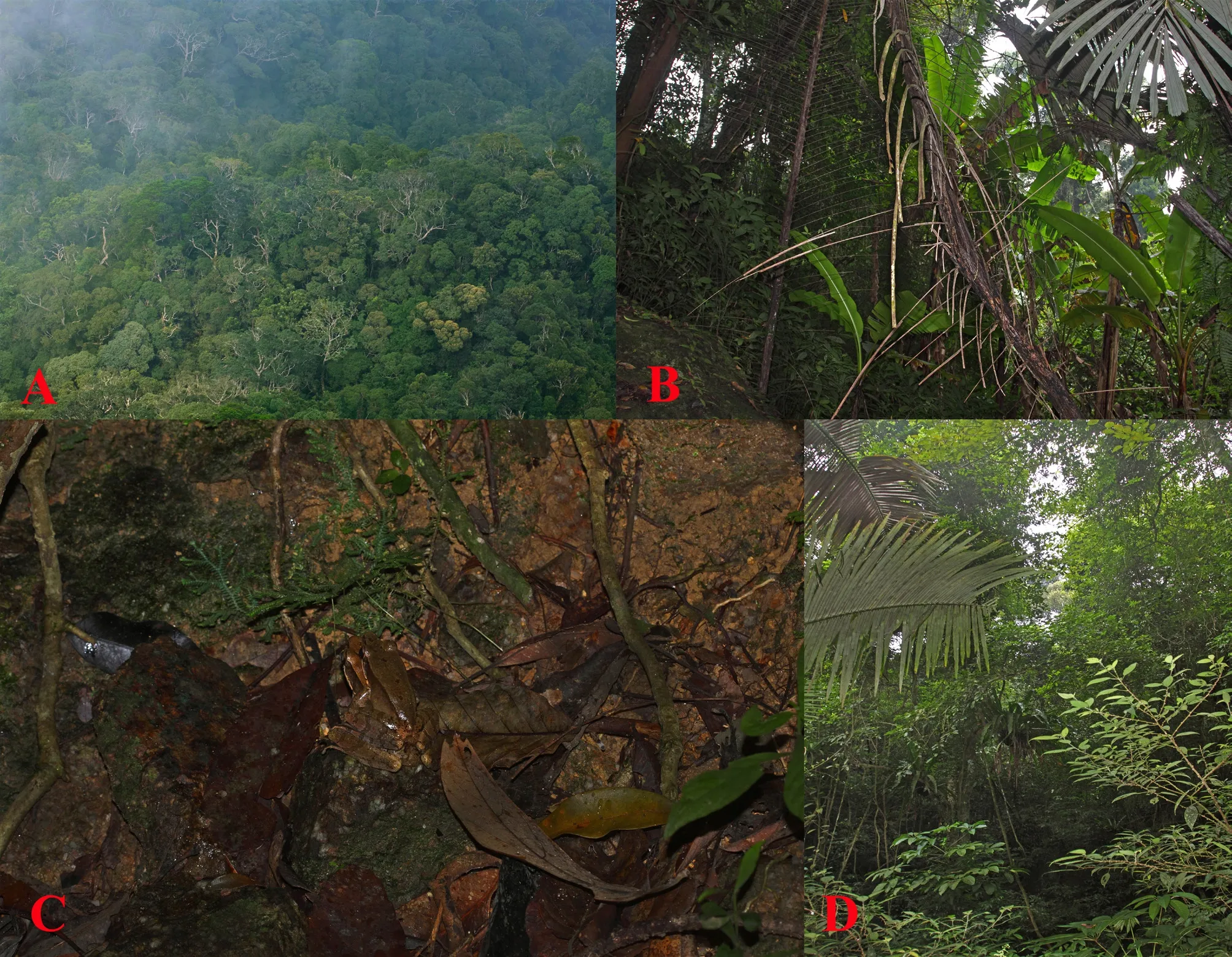
Figure 4 The habitat of Sinomicrurus houi sp. nov. on Tianchi, Jianfengling National Nature Reserve, Ledong County: A: The holistic habitat; B and D: the microhabitat; C: The microhabitat on the side of a stream where S. houi sp. nov. was found hunting. Photos by Mian HOU.
The new species is currently known from the NNRs of Diaoluoshan, Jianfengling and Wuzhishan, these three localities are situated on the east and west slopes of Qiongzhong Mountain ranges respectively. Probably this species occurs in the entire Qiongzhong Mountains range at levels of about 500–900 m elevation and is endemic for Hainan Province, China.
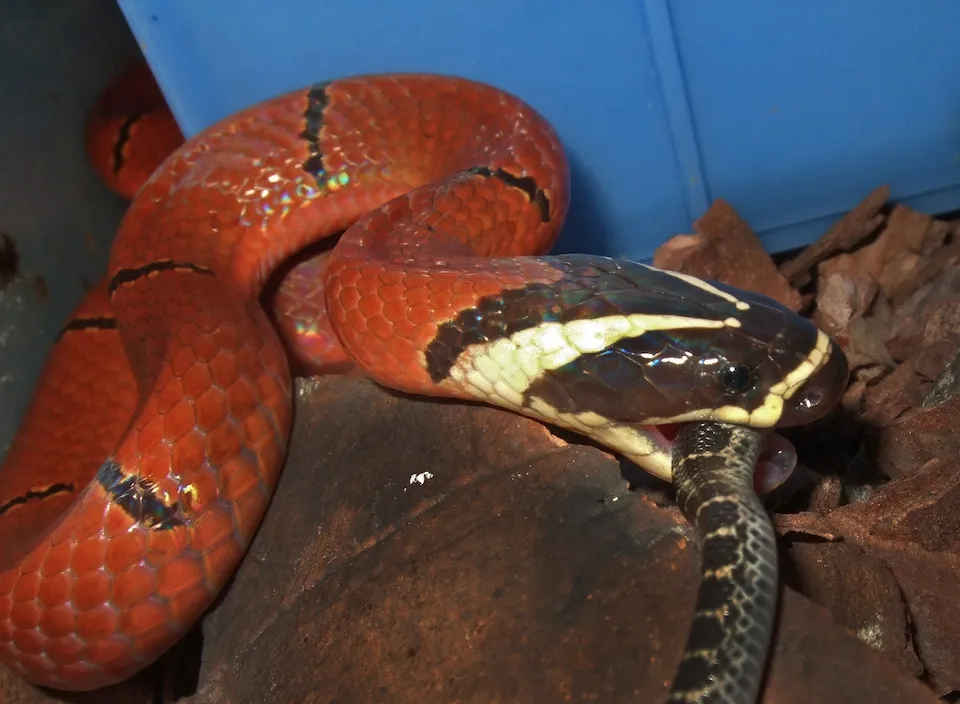
Figure 5 Sinomicrurus houi sp. nov. preyed on juveniles of Dinodon rufozonatum in captivity. Photo by Hang YANG and Wei LI.
The three NNRs from whichS.houisp. nov. is known harbour more than 95% species of the fauna of Hainan,especially many endemic species are ranged there, such asNomascus hainanus,Petaurista hainana,Neohylomys hainanensis,Polyplectron katsumatae,Arborophila ardens,Phylloscopus hainanus,Cuora galbinifrons hainanensis,Achalinus hainanus,Dinodon rosozonatum,Xenopeltis hainanensis hainanensis,Goniurosaurus hainanensis,Goniurosaurus bawanglingensis,Gekko similignum,Tylototriton hainanensis,Hylarana spinulosa,Nidirana hainanensis,Odorrana hainanensis,Limnonectes fragilis,Amolops torrentis,Amolops hainanensis,Kurixalus hainanus,Liuixalus hainanus,Liuixalus ocellatusetc. (Frost, 2017; Gonget al., 2006;Shiet al., 2011; Shi and Meng, 2001; Uetzet al., 2017;Wuet al., 2003).
AcknowledgmentsWe are grateful to Yuezhao WANG(Chengdu Institute of Biology, Chinese Academy of Science) and Jishan WANG (Kunming Institute of Zoology, Chinese Academy of Science) for share the very important collections in the CIB and KIZ ofSinomicrurusspecimens and to Pipeng LI (Shenyang Normal University), and Huanqiang CHEN (Jiangfengling National Forest Park) for their assistances with field surveys, Jichao WANG (Hainan Normal University),Chungwei YOU (Green Nature Experience Co., Ltd.),Liang Zhang (Guangdong Institute of Applied Biological Resources), Teppei JONO (University of the Ryukyus)and Ibuki FUKUYAMA (Kyoto University) for providing the important rerferences and field imformations.We thank Gernot Vogel (Society for Southeast Asian Herpetology) for his help with literature. This research was funded by the National Natural Science Foundation of China (31471968), Key Discipline of Ecology and Research Platform of Bioresource Institution, Huangshan University.
Chen J. M., Tang X. S., Huang S. 2013.Sinomicrurus kelloggiFirstly Found in Anhui Province, China. J Zool, 48(1): 134–135(In Chinese with English abstract)
Chu Y. Z., Huang Q. Y. 1990. The herpetofauna of Jianfengling,Hainan, China. Pp. 150–152. In Jiang Y. M. (Ed.) 1992. A Collection of Papers on Herpetology. Chengdu Institute of Biology, Academia Sinica, Chengdu, China
Frost D. R. 2017. Amphibian Species of the World: an Online Reference, Version 6.0. Electronic Database. Retrieved from http://researchamnhorg/vz/herpetology/amphibia/
Gong S. P., Shi H. T., Xu R. M., Wang Z. W., Xu J. P., Zhang Y.F. 2006. A survey of freshwater turtles in Jianfengling Nature Reserve, Hainan Province, China. J Zool, 41(1): 80–83 (In Chinese with English abstract)
Günther A. 1858. Catalogue of Colubrine snakes of the British Museum. London, I-XVI, 1–281
Günther A. 1864. The Reptiles of British India.London (Taylor &Francis), xxvii + 452 pp
Günther A. 1868. Sixth account of new species of snakes in the collection of the British Museum. Annals and Magazine of Natural History, 1: 413–429
Ji D. M., Wen S. S. 2002. Atlas of reptiles of China. Zhengzhou,China: Henan science and Technology Press (In Chinese)
Keogh J. S. 1998. Molecular phylogeny of elapid snakes and a consideration of their biogeographic history. Biol J Linn Soc, 63:177–203
Mcdowell S. B. 1967.Aspidomorphus, a genus of New Guinea snakes of the family Elapidae, with notes on related genera. J Zool, London 51: 497–543
Mcdowell S. B. 1969.Toxicocalamus, a New Guinea genus of snakes of the family Elapidae. J Zoology, 159: 443–511
Mell R. 1929. List of Chinese snakes. Lingnan Sci J, 8: 199–219
Nakamura K., Ueno S. I. 1963.Japanese Reptiles and Amphibians in Colour, 1st ed. Hoikusha, Osaka (In Japanese)
Orlov N., Ananjeva A., Ryabov S., Rao D. Q. 2003. Venomous snakes in Southern China. Reptilia (GB), 31: 22–29
Pope C. H. 1928. Four new snakes and a new lizard from South China. New York: American Museum Novitates, 320: 1–6
Reinhardt J. T. 1844. Description of a new species of venomous snake,Elaps macclellandi.Calcutta J Nat Hist, 4: 532–534
Shang G. S., Lee P. H., Yang Y. J. 2009. An illustrated handbook of amphibians and reptiles, Taiwan. Owl Pulishing House, Cite Co. ltd. 366 pp (In Chinese)
Shi H. T., Meng J. L. 2001. A guid to Hainan terrestrial vertebrate.Hainan Publishing House (In Chinese)
Shi H. T., Zhao E. M., Wang L. J. 2011. Herpetofauna of Hainan.Science Press (In Chinese)
Slowinski J. B., Boundy J., Lawson R. 2001. The phylogenetic relationships of Asian coral snakes (Elapidae:CalliophisandMaticora) based on morphological and molecular characters.Herpetologica, 57(2): 233–245
Slowinski J. B., Keogh J. S. 2000. Phylogenetic relationships of elapid snakes based on cytochrome b mtDNA sequences. Mol Phylo Evol, 15: 157–164
Smith E. N., Campbell J. A. 1994. A new species ofRhadinaea(Colubridae) from the Caribbean versant of Guatemala.Occasional Papers of the Museum of Natural History of the University of Kansas, 167: 1–9
Smith E. N., Arachchi K. M., Somaweera R. 2008. A new species of coralsnake of the genusCalliophis(Squamata: Elapidae) from the Central Province of Sri Lanka. Zootaxa,1847: 19–33
Smith M. A. 1943. The Fauna of British India, Ceylon and Burma,Including the Whole of the Indo-Chinese Sub-Region. Reptilia and Amphibia. 3 (Serpentes). Taylor and Francis, London. 583
Steindachner F. 1913. Über zwei neue Schlangenarten aus Formosa. Anzeiger der Kaiserlichen Akademie der Wissenschaften, Mathematisch-Naturwissenschaftliche Classe.Vienna, Ser. 50: 218–220
Stejneger L. 1907. Herpetology of Japan and adjacent territory.Smithsonian Institution, United States National Museum.Bulletin 58: xx, 1–577
Sun G. Z., Luo W. X., Wang J. S. 2015. Kellogg's Coral Snake(Sinomicrurus kelloggi) Found in Laojunshan, Yunnan, China. J Zool, 50(2): 242
Takahashi S. 1930. Terrestrial Snakes of Japan. Shunyo-do, Tokyo,Japan (In Japanese)
Uetz P., Freed P., Hošek J. 2017. The Reptile Database. Retrieved from http://www.reptile-database.org
Vogel G., David P. 2010. A new species of the genusLycodon(Boie, 1826) from Yunnan Province, China (Serpentes:Colubridae). Bonn Zool Bull, 57(2): 289–296
Vogel G., Luo J. 2011. A new species of the genusLycodon(Boie,1826) from the southwestern mountains of China (Squamata:Colubridae). Zootaxa, 2807: 29–40
Wall F. 1910. Notes on snakes collected in upper Assam. Journal of the Bombay Natural History Society, Vol. XIX: 825–845
Wall F. 1913. Notes on some interesting snakes recently presented to the society. Journal of the Bombay Natural History Society,Vol. XXII: 689
Wall F. 1923. Notes on a collection of snakes from Sinlum Kaba.Journal of the Bombay Natural History Society, Vol. XXIX:466–468
Wang D. Q., Yang D. C., Peng L. F., Cheng Z. W., Xu J. C., Hu X. Q., Huang S. 2015.Sinomicrurus kelloggiFirstly Found in Yunnan Province, China. Sichuan J Zool, 34(2): 314 (In Chinese)
Wang J. C. 2014. Wild vertebrate in Diaoluoshan, Hainan, China.China Forestry Publishing House, Beijing, China.
Wu Y., Jiang H. S., Peng H. Y., Li S. N., Wang W. Y. 2003.Study on the species biodiversity of mammals in Daoluoshan Mountain. J Guangzhou Univ (Nat Sci Ed), 2(6): 505–511 (In Chinese with English abstract)
Zhao E. M. 1990. Herpetofauna and zoogeography of Hainan Island. Pp. 354–363.InZhao E. M. 1990. From water onto land-A Festschrift of Dr. Cheng-chao Liu for his Birth 90th Anniversary. China. Beijing, China: Forestry Publishing House(In Chinese with English abstract)
Zhao E. M. 1998. Fauna Sinica, Reptilia Vol. 3, Squamata:Serpentes. Science Press (In Chinese)
Zhao E. M. 2004. An eight-month survey of reptiles on Hainan Island. Sichuan J Zool, 24(3): 323–329
Zhao E. M. 2006. The snakes of China. Hefei, China, Anhui Sience and Technology Publ. House, Vol. I, 372 pp., Vol.II, 280 pp. (in Chinese)
Zhao E. M., Adler K. A. 1993. Herpetology of China [Oxford,Ohio]: Contributions to Herpetology 10. Society for the Study of Amphibians and Reptiles
猜你喜欢
杂志排行
Asian Herpetological Research的其它文章
- Effects of Increased Salinity on Growth, Development and Survival in Early Life Stages of the Green Toad Bufotes variabilis (Anura:Bufonidae)
- Sexual Dimorphism, Female Reproductive Characteristics and Egg Incubation in an Oviparous Forest Skink (Sphenomorphus incognitus) from South China
- Amphibian Species Contribute Similarly to Taxonomic, but not Functional and Phylogenetic Diversity: Inferences from Amphibian Biodiversity on Emei Mountain
- A Rapid, Non-invasive Method for Anatomical Observations of Tadpole Vertebrae in Vivo
- Three New Ranidae Mitogenomes and the Evolution of Mitochondrial Gene Rearrangements among Ranidae Species
- A New Species of Gracixalus (Anura: Rhacophoridae) from West Guangxi, China
